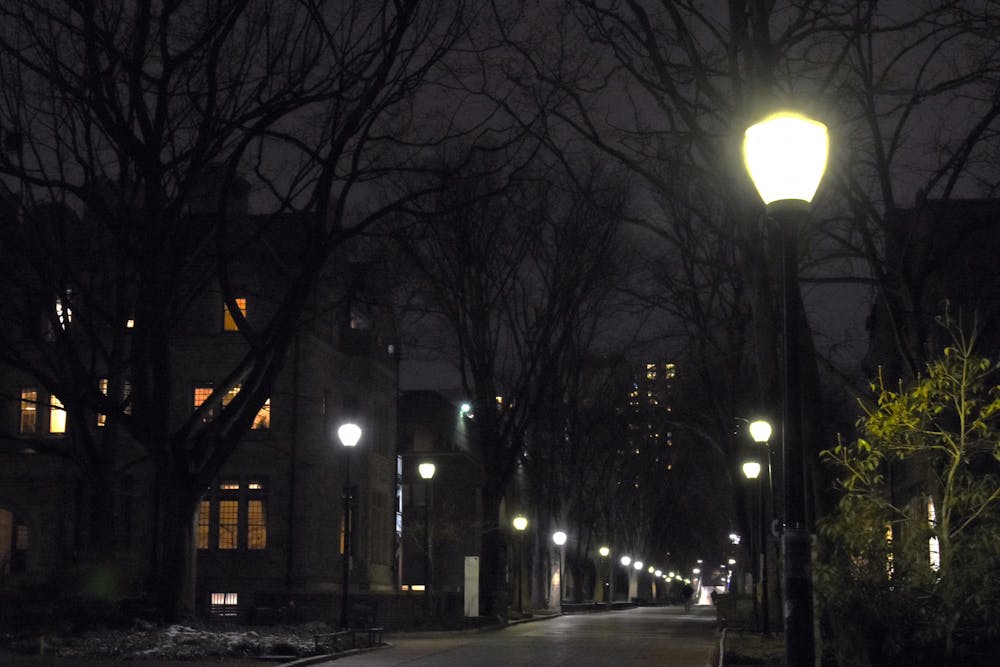According to Penn Sustainability, the main sources of energy used in Penn’s campus buildings account for over 90% of total energy, a portion of which includes electricity consumption. Sustainable lighting technologies have the potential to greatly reduce this consumption as well as Penn’s contribution to climate change. Most of Penn’s buildings contain lighting sources such as incandescent bulbs or compact fluorescent lamps (CFLs), which are known to be less efficient than light-emitting diodes (LEDs). Penn’s Facilities and Real Estate Services department acknowledges LED options under the current design criteria, but only allows for their installation under a set of conditions that impede large-scale implementation. Penn should consider launching a campus-wide effort to replace traditional lighting sources with LEDs. Doing so would not only reduce Penn’s energy bills, carbon footprint, and maintenance needs. It would also impact its students’ learning experience and improve the health and safety of its community by preventing light pollution.
LEDs possess a number of properties that make them sustainable. LEDs require much less wattage than incandescent bulbs or CFLs and are more efficient and longer-lasting. Traditional lighting sources release a quarter or less of their energy as light, whereas LEDs emit a higher proportion while rendering brighter light. Incandescent lamps convert about 10% of their fed electricity into light, while LEDs convert almost 100% of their consumed energy into light. Unlike CFLs, LEDs contain no mercury (a toxic element), and at least 95% of an LED is recyclable. The Department of Energy predicts that the energy savings from LEDs could top 569 terawatt-hours per year by 2035, equivalent to the annual output of more than 92 1,000-megawatt power plants. Poised to undergo rapid improvement in efficiency and cost reductions, LEDs have the ability to contribute to Penn’s climate initiatives by allowing room for investment in novel sustainability projects.
Under its current design standards, FRES states that, “While the University Guideline contains LED options, LED technology is only to be utilized in special applications with approval from the University Engineering Department,'' and that “Penn prefers fixtures manufactured for incandescent lamps paired with LED replacement lamps.'' FRES also provides performance specifications for LED fixtures, which should be provided by a manufacturer with a minimum of 8 years’ experience that provides a minimum 5 years of warranty on all electrical parts. Stouch Lighting, which specializes in LED installations for schools and universities, is based in Delaware County and meets these requirements. Founded in 2009, Stouch’s website contains a criteria page with warranty specifications and an archive with successful projects such as the West Chester School District, Neumann University, Pathway School, and the Franklin Institute, all of which reduced energy consumption by at least 63% upon switching to LEDs.
Philadelphia’s Office of Sustainability recently issued a Request for Qualifications (RFQ) for the procurement of a city-wide LED street lighting conversion project. Roughly 8,500 street lights in Philadelphia have been converted. According to Richard Montanez, Deputy Commissioner of the Streets Department, Philadelphia spends about $15 million per year on street lights. With LEDs, the City could save $5 million to $6 million per year. The first phase of the procurement was to build a list of vendors who will be eligible to respond to future requests for proposals. Penn can follow a similar procedure in its campus-wide switch to LEDs and in turn contribute to the City’s Municipal Energy Master Plan efficiency goals.
Nationally, many universities have switched to LEDs already. Stony Brook University, a research university in New York, took part in the state's BuildSmart program, which is designed to achieve energy efficiency in state government buildings. Stony Brook's project replaced existing lighting with LEDs across its medical facilities (roughly 38,000 lamps) and has helped Stony Brook save $700,000 per year. Similarly, staff members at the University of Michigan-Dearborn have been installing LEDs across campus since 2015. The conversion of the parking structure alone saves the University around $21,000 per year. That school is also taking advantage of incentives offered by the local energy company to progress the switch. Likewise, Penn can also take advantage of the commercial LED incentives offered by PECO to maximize its savings.
LEDs could have crucial impacts on Penn students’ health and safety upon implementation. Studies have found that LED lights can be tuned to imitate natural light, which is known to improve concentration and boost a student’s learning ability. LEDs have also been found to boost cognitive skills and lower students’ rates of error of omission. Since bright lights are used to treat several types of depression, including Seasonal Affective Disorder, switching to LEDs could help students who suffer from such hardships at Penn.
Penn has consistently expanded its campus and become a driving force in Philadelphia’s infrastructure. Since 2006, Penn has added 6 million square feet of construction and has reinvested in 2.7 million square feet of renovated space while adding 30.25 acres of open space. The West Philadelphia campus alone consists of 299 acres and 217 buildings. Over a decade ago, Penn launched Penn Connects, a visionary program that details the University’s development plans. The program is currently in its third phase and does not mention LED lighting initiatives. The fourth phase, beginning in 2023, is a significant opportunity to include a campus-wide transition towards LEDs and is something that the new President, M. Elizabeth Magill, should consider spearheading.
If Penn wants to achieve higher energy efficiency and become a leading figure in promoting sustainable practices, it must demonstrate its commitment to investing in the future of its impact on the environment. Switching to LEDs as a major if not primary source of lighting at Penn is a secure choice that aligns with the University’s perspectives on environmental sustainability. LEDs are literally up for grabs, and it’s time for Penn to reap the benefits they provide as strong components of the lighting industry.
MORE FROM SEAN DERESH:
Penn should commit to a long-term offshore wind energy power purchase agreement
SEAN DERESH is a College and Engineering junior in the Vagelos Integrated Program in Energy Research. His email is sderesh@sas.upenn.edu.









